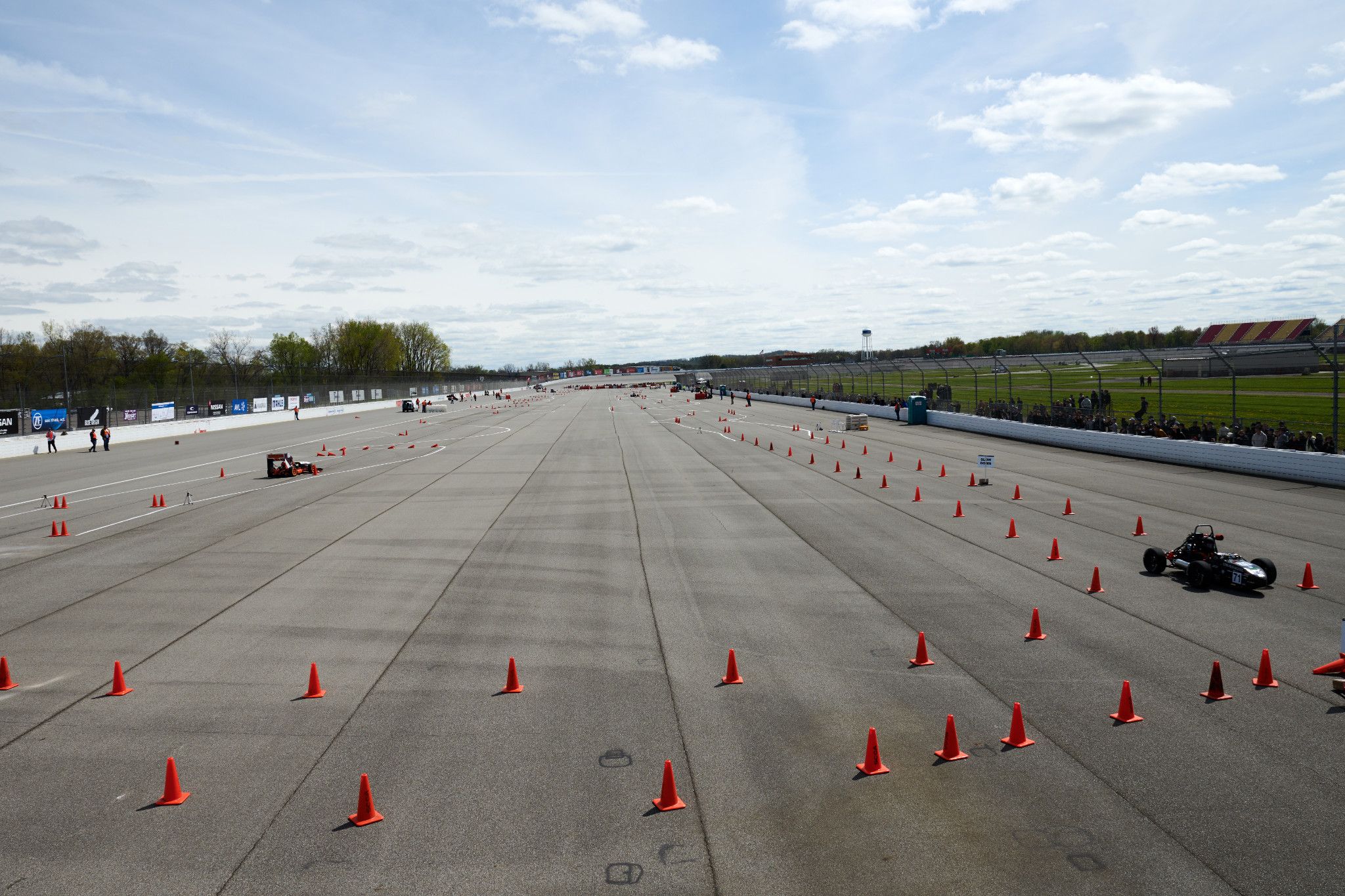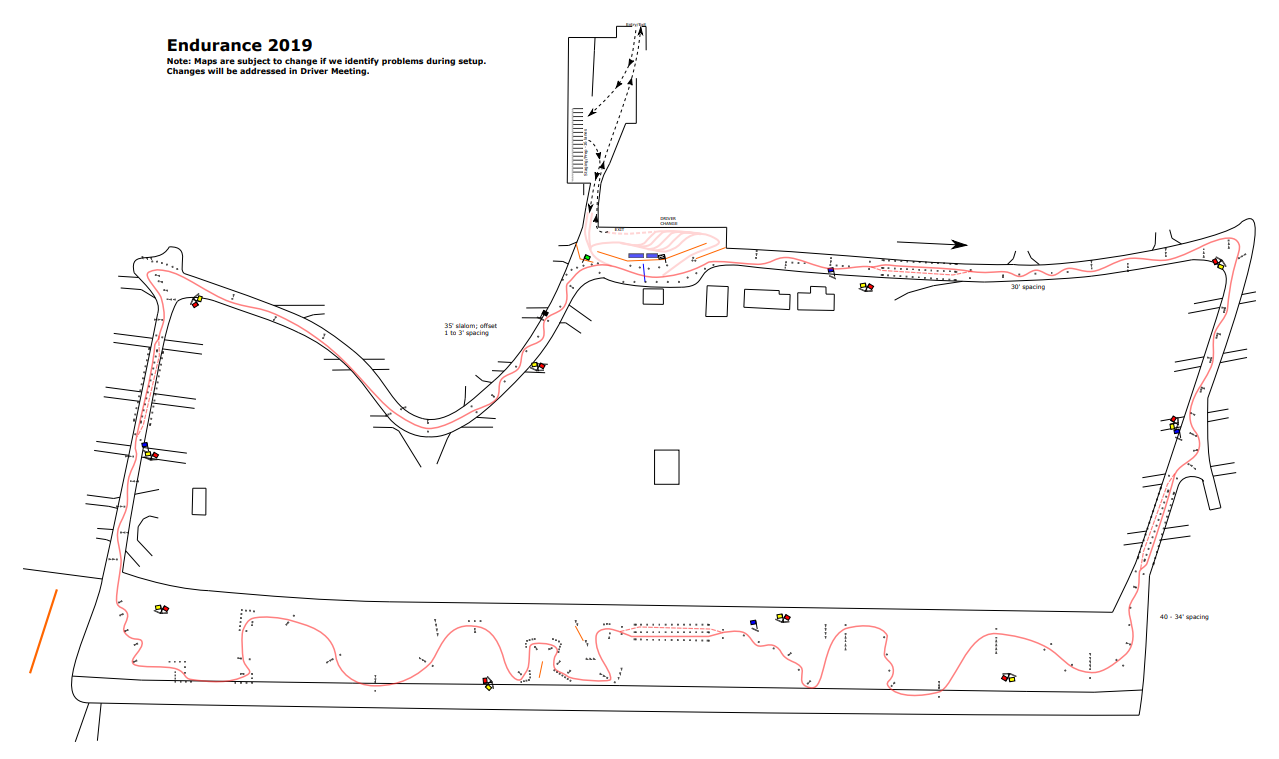Description of Events at Competitions
Overview
At Formula SAE Competitions, the team with the fastest driver, lightest car, best aerodynamic design, or most powerful engine, doesn't always win. While having a team with those aforementioned characteristics helps, there are a few more factors to winning a Formula SAE event.
Wednesday
Technical Inspection
- To get started, each car must roll over to the technical inspection tent, where tech judges will thoroughly check every component on the car and make sure it is compliant with the 136 page rule book. With a well prepared car, this portion of the event takes 30 minutes to an hour.

Thursday
Safety Tests
- Before competing in the performance events, the car must pass the following tests:
- Tilt Test: This ensures fluids do not leak out of the car at 45 and 60 degree angles.
- Noise Test: Meet a decibel limit at idle (103 dB) and at a specific high RPM (110 dB) given based on engine displacement, and a few other factors.
- Brake Test: Slightly accelerate, then prove your car can stop within the braking zone while having all 4 tires lock up in the zone. They must lock to pass to prove the car has adequate braking force.

Design Judging
- One of the most prestigious parts of the Formula SAE competition is the design presentation given to experienced engineers from automotive, aircraft, space exploration, composite materials, power generation, and many other types of engineering companies. They provide critique and analyze how well the Design Leads understand their system. They want to see proof that the best designs were implemented by showing reasoning for why the design was chosen followed by simulation data, and real world testing data while comparing to other possibilities. If the judges believe the team understands their designs exceptionally, they will receive a bid to the design finals.




Cost Report
- Throughout the year the team has to consider budget, production methods, and efficiency of production as an integral part of the design process. At competition, we present a detailed report of the total cost. During the event, a real case scenario is given by the judges as well. Then scores are based off of overall cost, real case scenario cost, and the quality of the presented report.
Presentation Event
- At the Presentation event, the team's ability to develop and deliver a comprehensive business, logistical, production, or technical case that will convince outside interests to invest in the team's concept.
Friday
Skid Pad
- At the skid pad the car's ability to produce lateral grip is tested. This is done on a flat constant radius pair of turns. Drivers complete two laps turning one direction, then switch to the other circle and turn the opposite direction. Scoring from the event is the average of the best left turning lap and the best right turning lap.

Acceleration
- Acceleration measures the car's ability to travel 75 meters the fastest.
Autocross
-
An attempt consists of a 1 lap run through a series of slaloms, small hairpin turns, large sweeping turns, and other challenging maneuvers.
- The time you finish with, qualifies you for a group in Endurance. The best times race at the end of the day on Saturday. It’s crucial to be in a group that has similar speed to your car so you don’t lose overall time in Endurance by being behind slower cars.
-
Each of Friday's dynamic events allow 4 attempts total, 2 per driver.

Design Feedback
- After the design judges have a chance to review all of the team's information, they come to the paddock to give feedback. This is a time to hear constructive criticism, ask for advice, and hear what they liked about the overall design.
Saturday
Endurance and Fuel Economy
- The main event, Endurance, is a distance of 22 km (13.67 miles) including a driver swap halfway through. Finishing position in Endurance is determined by time to complete, and cars are spaced equally about the course at the beginning of each session (usually 6-7 cars per session). Wheel to wheel racing isn’t a part of the event, so overtaking is done in passing zones where the slower car gets flagged to let the faster car go by. Typically, only 40-50% of all teams finish Endurance, so fully completing the event is a huge accomplishment. With Endurance being worth almost 40% of the overall score, it is crucial to finish for a top overall result.

Public Design Review & Presentation Highlights


Awards Ceremony

Points Distribution of Events
| Event | Points |
|
Presentation |
75 |
| Cost Report | 100 |
| Design Judging | 150 |
| Skid-Pad | 75 |
| Acceleration | 100 |
| Fuel Efficiency | 100 |
| Autocross | 125 |
| Endurance | 275 |
| Total Points | 1000 |